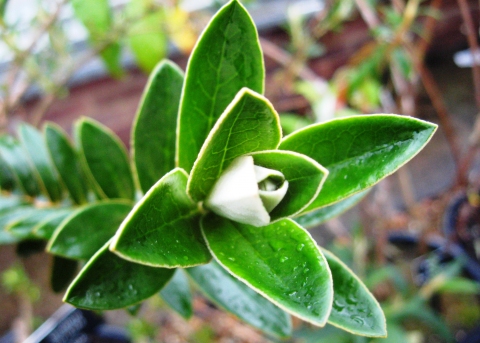Buddleja coriacea
J.Rémy
Scrophulariaceae
Buddleja buxifolia Kraenzl.
Buddleja oblongifolia Rusby
Buddleja rhododendroides Kraenzl.
Buddleja ususch Kraenzl.
Buddleja utilis Kraenzl.
Common Name:

Leaves
Photograph by: Ptelea
Creative Commons Attribution-Share Alike 3.0
General Information
Buddleja coriacea is an evergreen shrub or small tree with a wide crown that in some areas can grow up to 12 metres tall with a bole 40cm in diameter[
]. Branches are produced almost from the ground[
].
The plant is utilized within its native range to provide shelter and frost protection for crops. It also supplies fuel and medicine.
Known Hazards
None known
Botanical References
Range
S. America - Bolivia, Peru.
Habitat
Medium deep, rocky, dry to semi-humid soils at elevations up to 4,400 metres[
].
Properties
| Medicinal Rating |      |
| Other Uses Rating |      |
| Habit | Evergreen Shrub |
| Height | 7.00 m |
| Cultivation Status | Wild |
Cultivation Details
A plant of the highland tropics, generally found at elevations above 3,000 metres, but sometimes descending to 2,300 metres. It grows best in areas with a mean annual precipitation about 600mm[
]. It can withstand temperatures below 0°c[
].
Requires a sunny position. Found in medium deep, rocky, dry to semi-humid soils in the wild[
]. The plant tolerates strong constant winds[
]. Plants are susceptible to drought[
].
Plants are susceptible to fires[
].
Edible Uses
None known
Medicinal
The plant is sometimes used for medicine[
].
Agroforestry Uses:
It is often planted around fields where its dense foliage makes it suitable for windbreaks and frost protection[
].
Other Uses
The wood is used for construction and firewood[
].
Propagation
Seed - it does not require pre-treatment[
]. The small seeds are sown in a nursery seedbed, only just covering them with soil. Germination normally starts after 10 days and is complete within 20 days. The seedlings are very fragile and special care must be taken to protect them from desiccation and direct sunlight[
].
Because of their fragile nature the seedlings should stay in the seedbed for at least 10 weeks. After pricking out, the seedlings remain in the nursery for another 14 - 18 months until they are 30 - 40 cm tall and ready for planting out[
].
Vegetative propagation by cuttings is also possible and plantlets produced this way are less fragile[
].
If you have any useful information about this plant, please leave a comment. Comments have to be approved before they are shown here.
 Useful Tropical Plants Database 2014 by
Ken Fern,
web interface by
Ajna Fern
with help from
Richard Morris.
Useful Tropical Plants Database 2014 by
Ken Fern,
web interface by
Ajna Fern
with help from
Richard Morris.